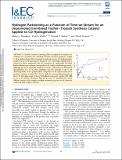Files in this item
Hydrogen partitioning as a function of time-on-stream for an unpromoted iron-based Fischer-Tropsch synthesis catalyst applied to CO hydrogenation
Item metadata
| dc.contributor.author | Davidson, Alisha L. | |
| dc.contributor.author | Webb, Paul B. | |
| dc.contributor.author | Parker, Stewart F. | |
| dc.contributor.author | Lennon, David | |
| dc.date.accessioned | 2020-01-09T13:30:03Z | |
| dc.date.available | 2020-01-09T13:30:03Z | |
| dc.date.issued | 2020-01-08 | |
| dc.identifier | 265462881 | |
| dc.identifier | 853339bb-0078-4474-ae9b-0a8d472dabbf | |
| dc.identifier | 85077172275 | |
| dc.identifier | 000507144500007 | |
| dc.identifier.citation | Davidson , A L , Webb , P B , Parker , S F & Lennon , D 2020 , ' Hydrogen partitioning as a function of time-on-stream for an unpromoted iron-based Fischer-Tropsch synthesis catalyst applied to CO hydrogenation ' , Industrial and Engineering Chemistry Research , vol. 59 , no. 1 , pp. 52-60 . https://doi.org/10.1021/acs.iecr.9b04636 | en |
| dc.identifier.issn | 0888-5885 | |
| dc.identifier.other | ORCID: /0000-0003-2532-344X/work/67167793 | |
| dc.identifier.uri | https://hdl.handle.net/10023/19256 | |
| dc.description | Sasol Ltd., the EPSRC (award reference EP/P505534/1), and the University of Glasgow are thanked for the provision of a postgraduate studentship (ALD). The STFC Rutherford Appleton Laboratory is thanked for access to neutron beam facilities. The Royal Society is thanked for the provision of an Industry Fellowship (PBW). | en |
| dc.description.abstract | Inelastic neutron scattering (INS) is employed to examine the evolution of a promoter-free iron-based Fischer-Tropsch synthesis catalyst (∼10 g catalyst charge) that is exposed to ambient pressure CO hydrogenation at 623 K for up to 10 days time-on-stream (T-o-S). The longer reaction time is selected to better understand how the formation of a previously described hydrocarbonaceous overlayer corresponds to the catalyst conditioning process. Although the onset of pseudo steady-state reactor performance is observed at approximately 9 h T-o-S, INS establishes that the intensity of the C-H stretching mode of the sp3-hybridized component of the hydrocarbonaceous overlayer saturates at about 24 h T-o-S, while the corresponding intensity of the C-H stretching mode of the sp2-hybridized component requires 100-200 h T-o-S to achieve saturation. This novel series of measurements reveal different aspects of the complex catalyst evolutionary process to be indirectly connected with catalytic turnover. | |
| dc.format.extent | 1828451 | |
| dc.language.iso | eng | |
| dc.relation.ispartof | Industrial and Engineering Chemistry Research | en |
| dc.subject | QD Chemistry | en |
| dc.subject | Chemistry(all) | en |
| dc.subject | Chemical Engineering(all) | en |
| dc.subject | Industrial and Manufacturing Engineering | en |
| dc.subject | NDAS | en |
| dc.subject.lcc | QD | en |
| dc.title | Hydrogen partitioning as a function of time-on-stream for an unpromoted iron-based Fischer-Tropsch synthesis catalyst applied to CO hydrogenation | en |
| dc.type | Journal article | en |
| dc.contributor.sponsor | The Royal Society | en |
| dc.contributor.institution | University of St Andrews. School of Chemistry | en |
| dc.identifier.doi | https://doi.org/10.1021/acs.iecr.9b04636 | |
| dc.description.status | Peer reviewed | en |
| dc.identifier.grantnumber | IF140013 | en |
This item appears in the following Collection(s)
Items in the St Andrews Research Repository are protected by copyright, with all rights reserved, unless otherwise indicated.

